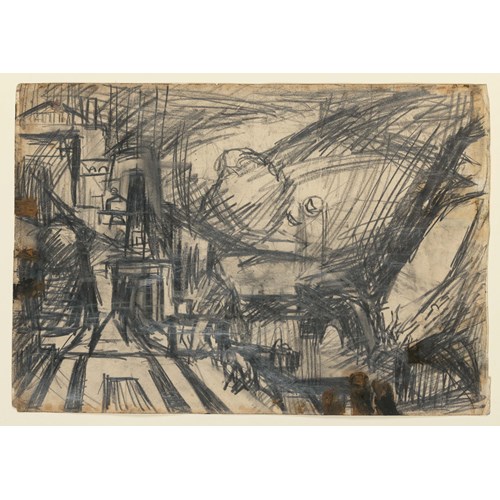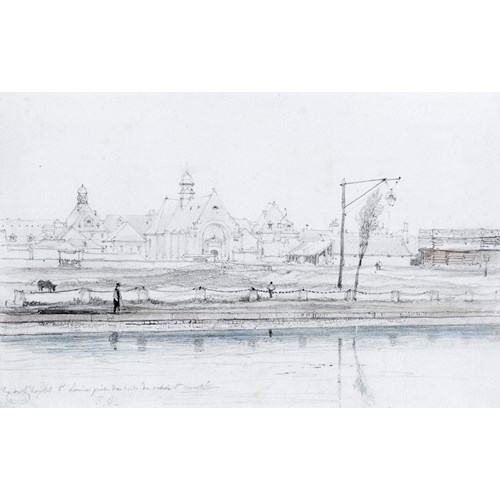Marketplace
A View of the Monastery and Sanctuary of La Verna, Tuscany
Théodore CARUELLE D'ALIGNY
A View of the Monastery and Sanctuary of La Verna, Tuscany
Medium Pen and brown ink and light brown wash
Dimension 40 x 59.9 cm (15³/₄ x 23⁵/₈ inches)
This large and impressive sheet is likely to date from Caruelle d’Aligny’s second visit to Italy in 1834, when his drawings became grander in scale and more expansive in composition, with a preference for pen and brown ink instead of the fine pencil characteristic of his earlier Italian drawings. As Michael Clarke has noted of the artist’s second Italian tour, ‘Aligny’s drawings from this trip have an assured quality in what had become his characteristic manner, developed over the preceding decade, in which form and construction are achieved by mainly linear means and shading is boldly indicated in a schematic manner. Horizons are raised and…the artist exhibits a particular fascination with large rocks set into the landscape, through whose depiction he is able to achieve a purity of form. Indeed, his highly original drawing style remains of considerably greater interest than the often insipid quality achieved in his finished paintings.’
Similarly, another modern scholar has written of Aligny’s draughtsmanship that ‘He was especially attracted to sunny, spacious vistas which he studied in plein air, creating drawings of far greater intricacy, monumentality, and assurance than his relatively timid paintings. Early and continued contact with Corot undoubtedly aided Aligny’s development of spatial clarity.’ Views of landscapes in Tuscany such as the present large sheet are, however, quite rare among the Italian drawings of Aligny, who mainly worked further south, around Rome and Naples.
Long associated with Saint Francis of Assisi, the Sanctuary of La Verna lies at the summit of the chalky cliffs of the Monte della Verna, at the edge of the Casentino forest in Tuscany. In 1213 Count Orlando Cattani of Chiusi della Verna gave the mountain and the surrounding land to Saint Francis and the Franciscan order, as a place suitable for contemplation and prayer. In the succeeding years the first hermitage was built, with a number of small cells around the church of Santa Maria degli Angeli. It was at La Verna that Saint Francis retreated in prayer and meditation, and where, in September 1224, he received the stigmata. A larger church, the Basilica of Santa Maria Assunta, was built between the 14th and 16th centuries, and today houses several relics of the Saint.
As has been noted of the period in which Aligny was working in Italy, ‘the beauty of the Italian landscape was celebrated in a growing body of travel literature, which guided visitors to the most famous sites.’ One early 19th century English visitor to the area wrote that ‘La Verna has a most curious appearance from whatever point it is viewed. Imagine a barren mountain crowned with a circle of rocks, for the greater part rising perpendicularly, and to the height, in some instances, of two or three hundred feet, - according to my conjecture, although books talk of double that height. It would bear a resemblance to the ruins of a gigantic castle, were it not that the tongue of land (as the Italians call it) upon the rocks is covered with a thick and lofty wood…Few places can be more romantic and picturesque than La Verna. Owing to the inequalities of the ground, and its being thickly covered with wood, the smallness of its extent is concealed, so that in many parts it is difficult not to imagine oneself in the depths of a wide forest. Then the sudden and abrupt heights, the chasms, the rocks torn and splintered into such various shapes, all add to the enchantment. Trees flourish there remarkably well, and the banks are beautiful with wild flowers.’
Writing in June 1844, another traveller noted that ‘La Verna is, in fact, a Hospice, on the summit of a pass leading from Bibiena, Chitignano, and Pieve San Stefano, directly over the Apennines. On the side of the mountain we found the heat of the sun very great; but on arriving at the Convent, we were shown into a room with massive walls, quite shaded from the sun, so that it felt very chilly, and we accepted with delight the offer of a fire, which we soon saw blazing up the capacious chimney. We could scarcely have anticipated enjoying a fire-side in the middle of the day on the 7th of June, in Italy…We then visited the various shrines and spots of particular sanctity in the immediate neighbourhood of the Convent. One of the brethren, and two of the country people, accompanied us. At every altar they knelt in prayer; and in the cave in which Saint Francis, the founder of the Convent, had made his bed – a dark cave now dripping audibly with water – the silence was broken only by their subdued voices, and the sound of the dropping…The position of La Verna is very commanding, giving it somewhat the appearance of a fortress or strong-hold. Its wood scenery is beautifully diversified with rock, affording the greatest landscape studies both in outline and colour; and all about the Convent you catch most picturesque figures of the monks, or of the country-people, in attitudes of adoration before the various shrines and altars.’
Pen and brown ink and light brown wash, heightened with white chalk, over an underdrawing in pencil.
Similarly, another modern scholar has written of Aligny’s draughtsmanship that ‘He was especially attracted to sunny, spacious vistas which he studied in plein air, creating drawings of far greater intricacy, monumentality, and assurance than his relatively timid paintings. Early and continued contact with Corot undoubtedly aided Aligny’s development of spatial clarity.’ Views of landscapes in Tuscany such as the present large sheet are, however, quite rare among the Italian drawings of Aligny, who mainly worked further south, around Rome and Naples.
Long associated with Saint Francis of Assisi, the Sanctuary of La Verna lies at the summit of the chalky cliffs of the Monte della Verna, at the edge of the Casentino forest in Tuscany. In 1213 Count Orlando Cattani of Chiusi della Verna gave the mountain and the surrounding land to Saint Francis and the Franciscan order, as a place suitable for contemplation and prayer. In the succeeding years the first hermitage was built, with a number of small cells around the church of Santa Maria degli Angeli. It was at La Verna that Saint Francis retreated in prayer and meditation, and where, in September 1224, he received the stigmata. A larger church, the Basilica of Santa Maria Assunta, was built between the 14th and 16th centuries, and today houses several relics of the Saint.
As has been noted of the period in which Aligny was working in Italy, ‘the beauty of the Italian landscape was celebrated in a growing body of travel literature, which guided visitors to the most famous sites.’ One early 19th century English visitor to the area wrote that ‘La Verna has a most curious appearance from whatever point it is viewed. Imagine a barren mountain crowned with a circle of rocks, for the greater part rising perpendicularly, and to the height, in some instances, of two or three hundred feet, - according to my conjecture, although books talk of double that height. It would bear a resemblance to the ruins of a gigantic castle, were it not that the tongue of land (as the Italians call it) upon the rocks is covered with a thick and lofty wood…Few places can be more romantic and picturesque than La Verna. Owing to the inequalities of the ground, and its being thickly covered with wood, the smallness of its extent is concealed, so that in many parts it is difficult not to imagine oneself in the depths of a wide forest. Then the sudden and abrupt heights, the chasms, the rocks torn and splintered into such various shapes, all add to the enchantment. Trees flourish there remarkably well, and the banks are beautiful with wild flowers.’
Writing in June 1844, another traveller noted that ‘La Verna is, in fact, a Hospice, on the summit of a pass leading from Bibiena, Chitignano, and Pieve San Stefano, directly over the Apennines. On the side of the mountain we found the heat of the sun very great; but on arriving at the Convent, we were shown into a room with massive walls, quite shaded from the sun, so that it felt very chilly, and we accepted with delight the offer of a fire, which we soon saw blazing up the capacious chimney. We could scarcely have anticipated enjoying a fire-side in the middle of the day on the 7th of June, in Italy…We then visited the various shrines and spots of particular sanctity in the immediate neighbourhood of the Convent. One of the brethren, and two of the country people, accompanied us. At every altar they knelt in prayer; and in the cave in which Saint Francis, the founder of the Convent, had made his bed – a dark cave now dripping audibly with water – the silence was broken only by their subdued voices, and the sound of the dropping…The position of La Verna is very commanding, giving it somewhat the appearance of a fortress or strong-hold. Its wood scenery is beautifully diversified with rock, affording the greatest landscape studies both in outline and colour; and all about the Convent you catch most picturesque figures of the monks, or of the country-people, in attitudes of adoration before the various shrines and altars.’
Pen and brown ink and light brown wash, heightened with white chalk, over an underdrawing in pencil.
Medium: Pen and brown ink and light brown wash
Dimension: 40 x 59.9 cm (15³/₄ x 23⁵/₈ inches)
Provenance: Anonymous sale, Geneva, Hôtel de Ventes de Genève, 10 March 2010, lot 1137 [catalogue untraced].
More artworks from the Gallery







_T638636512051387495.jpg?width=500&height=500&mode=pad&scale=both&qlt=90&format=jpg)

_T638203653437635237.jpg?width=500&height=500&mode=pad&scale=both&qlt=90&format=jpg)